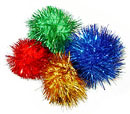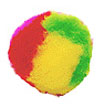Vol. 1, No. 40
Table of Contents
Assist Feeding – Feeding Location
Feline Nutrition – Just a few thoughts on Cat Food Preperation
Pro-Active Cat Care – Odd Behavior
Feline Obesity – Vinegar and Water Wipes
Kitty Potpourri – Our Favorite Cat Toys!, Part II
Assist Feeding – Feeding Location
by Kathy Fatheree
Where do you feed your cat?
If your cat is avoiding the feeding dish, take a long look at where it is located. A cat needs to feel safe and comfortable when eating. You may have had the dish in the same location for years, but the traffic patterns in your house may have changed, or kitty may be getting older and a little more fearful and what was an acceptable location before may not be now. When we are young, we feel invincible. As we age, we learn that we are vulnerable.
Feed your cat in a location that is out of the main traffic in your house. If you or your family members are walking by your cat when he or she is eating, it’s bound to be distracting.
Feed your cat away from the litter box. You would think that it was terribly distasteful to eat near a latrine right? Right! Cats have very sensitive noses so be careful not to let the odor of the litter box drift by!
Feed your cat in the same location everyday. When I go to feed my cats, they head for their own dish. Cats are somewhat creatures of habit so keep the feeding location the same everyday.
Cats in the wild need to be able to see and hear if predators are approaching. Your cat’s inner instincts are still at work, so feed your cat in a location where he or she can see and hear in all directions. For example, don’t feed your in the corner of a rooms.
When I built my house, I designed a huge pantry in the kitchen. The pantry door was a pocket door that would remain open at all times. One side was designed at the cat feeding area and even had a plug for a night light for nighttime grazing. I moved in, set up the food and water bowl. but nobody would eat in there. They felt trapped. only one way in and one way out. So much for my grand idea!
Let me tell you about my 4 kitties and where they like to eat:
Maya likes to eat at high locations such as on the table, on the counter or on one of the many boxes I still have in the kitchen since I’ve moved into a new house. She is a little scared of my other cats at times and feels safest up high.
Phoebe is a loner and prefers that her dish is at least 4 feet away from the other cat dishes. Around the corner is even better.
Nicholas and Miss Picasso are buds and like their dishes side-by-side. However, they enjoy having their dishes under the kitchen table. It must feel safe under there. probably like a kid’s fort. These two cats are my bravest of all, so I think they are just being goofy. I’m sure they will eat almost anywhere as long as they can eat together.
Each and every cat has its own comfort level and feeding location preferences. Be sensitive to your cat’s body language and let your cat tell you where he or she wants to eat.
Feline Nutrition – Just a few thoughts on Cat Food Preperation
Food Temperature:
This issue has been kicked around a plenty, and I’m not sure where it finally landed. The books say that kitty foods should be served at room temperature or as closely as possible to that, with the premise that cats will eat only what seems “natural” to them, and avoid all else. I’ve seen controversy to the written word, and in fact Lewie was a good example: He preferred his food cold, and would turn his nose up at warm stuff. Maybe he just liked the colder feel in his mouth or throat? I dunno.
Partial Cans of Food:
I have a friend nearby who says she just plops the pull-off lid back on the can and sticks it in the Fridge (when she’s serving less than a whole can). DO NOT do this, for several reasons: One, the food dries out far more quickly, and is subject to spoiling faster. Two, the food can (and WILL) pick up the flavor of other foods inside the Fridge. A covered, glass dish is ideal, but in the absence of that, at least seal the whole can inside a Ziploc sandwich bag.
ProActive Cat Care – Odd Behavior
by Garry White
Is it just odd Behavior?
We’re a flighty bunch, us cat-folks. One side of us watches for odd behavior with our kitties as a sign of impending problems, while the other side of us thinks there’s something wrong with a cat who doesn’t act daffy from time to time. Well, both sides of us are correct, but the line between “odd-okay” and “odd-not-okay” is a thin one. We realize that cats will act goofy now at times, and sometimes they’ll change a routine altogether. We see these things happen and we’re inclined to call it “normal”, but we must be careful not to fall into complacency. For example: A cat who always sleeps on the foot of the bed but suddenly takes to sleeping on a chair is probably just varying his lifestyle a little, and I wouldn’t be terribly concerned. But if that same bed-cat starts sleeping under the bed or in dark corners, that would get my full attention. Another scenario: Some cats’ general demeanor is to be standoffish, aloof; they prefer to be left alone most of the time. If this cat suddenly starts wanting to be close to you, he’s probably trying to get your attention.
So how do we differentiate? How do we tell if they’re just tired of sleeping on the bed, or if it means something else? First of all, we NOTE the change, and we look at any other changes we’ve noted recently. Then we REVIEW what we know about various ailment indicators to see if any (or all) of these changes in behavior fit somewhere.
Here’s a solid case in point: My Clark is Cat-B from above. He’s affectionate when he chooses to be, but the rest of the time he’s a “keep-your-hands-off-me” kind of cat. At bedtime, he’ll come and give me a few dozen head-bumps, stick around for a little petting, and then he’s off to his personal nightstand where he has slept for years. Well, lately he’s taken to sleeping right up close beside me atop the covers all night long. Tilt. I also noted that as I work on the computer these days, he’s up there frequently, pacing back and forth in front of the screen. TILT! In and of themselves, neither act is significant, but together they could mean something. So Dr. Sleuth, here, goes on the prowl, and sure enough I find something: His bodily functions (need I clarify?) seem okay, but I discover a change in eating habits. Instead of eating a healthy portion when he’s hungry (normal for him), I note that he visits the bowl many times throughout the day, but only nibbles each time, and I further note that he’s chewing only on one side of his mouth. Uh-oh.time to bring in the big guns. I had the good Dr. Dimmick to come visit us, and within seconds he discovers a badly abscessed tooth that has to come out.
Hopefully you see two things: One, the mild change in Clark’s sleeping routine was welcomed, but.it wasn’t Clark, so it triggered me to look for other signs. Two, Clark was sending me a message; he was telling me that something was wrong and that he wanted my attention.
Feline Obesity – Vinegar and Water Wipes
by Kathy Fatheree
Last week I told you the story about Phoebe and her anal sac removal due to becoming repeatedly impacted, and how after the surgery, the vet recommended another surgical procedure called Perivulvar Skin Fold Reduction to reduce further infections “back there.” Phoebe’s, being an obese cat, has fatty skin folds as well. I refused to put her through another surgery so soon and asked if putting Phoebe on a diet and bathing her rear would be practical and eliminate this problem.
The vet’s response was:
She needs to use a shampoo that is labeled for use on cats. However, I am doubtful that this approach will work for 2 reasons:
- It will be very difficult to get her to lose 4-5 pounds.
- If that happens, the extra skin that is now present will still be present so the skin fold will still be there. In fact, it might even be worse because there will be more loose skin.
Well, our vet was certainly correct about it being difficult to get Phoebe to lose weight. It’s been 10 months and Phoebe has lost only 2 pounds.
However, I did start bathing Phoebe’s rear on a weekly basis. I tried the cat shampoo, however it contained conditioners and it would not cut the oils. Instead I used a no-tears baby shampoo. Since Phoebe cannot reach her rear, I was not scared that she could ingest the soap residue, if any remained. This no-tear baby shampoo worked great. After bathing and rinsing, I blotted the area with toilet tissue to soak up most of the water and then used a warm hair dryer to dry the rest of the way. Yes, she growled and hissed and it sounded like a cat fight to anyone listening at the bathroom door, but Phoebe is smart and she knew that I was trying to help her. She eventually became accustomed to the bathing even though she still made a lot of noise. The bathing worked and 10 months later, we still have not had any more vaginal Skin fold pyoderma episodes. I only bathe her once a month now, but I do wipe her personal areas with tissue to remove any residue. Phoebe is so good that she actually lies down and let’s me wipe her without much fuss. Perhaps she figures that the wiping with the tissue is better than a bath any day!
I recently took Phoebe to the vet for her checkup and asked how she looked back there. The vet said I was doing a great job and Phoebe was just fine. The vet then recommended that I could use one of the new pet wipes that have become so popular. Me, being ever so cautious about cleaners asked if there was a natural way to wash Phoebe’s rear and the vet recommended that I make my own vinegar and water solution. She said that the wipes usually contain vinegar and vinegar is what actually kills the bacteria. What a great idea!
The vet recommended a 1-part vinegar to 4-parts water. Being curious, I went out on the Internet to search for a ratio of vinegar to water when bathing a cat and found ever combination under the sun. Most sites recommended a vinegar and water rinse following the shampooing to cut any soap residue and leave the skin and hair soft and pH balanced. In most cases the vinegar rinse was followed by a warm water rinse.
Here are the combinations I found:
1 part vinegar to 3 parts water
1 Teaspoon white vinegar into 1 quart warm water
2 tablespoons of vinegar in 2-3 gallons
½ cup of vinegar to 2 quarts water
½ cup vinegar to 1 gallon water
1 cup vinegar to two quarts of water
Is anyone a cook or extra good with comparing measurements? I didn’t do the conversions to see how these compare. If you’d like to do a comparison of these, please send me your results to: FeedBack (at) AssistFeed.com
With Phoebe, I used my vet’s recommendation of 1-part white vinegar to 4-parts water and this worked great!
Kitty Potpourri – Our Favorite Cat Toys!, Part II
by Dan Malenski
Last week, we talked about three of our favorite toys, that is, the plastic drinking straw, the swiveling feather on a pole, and a bouncy rubber ball that we are still trying to identify and find a source. This week, we will talk about two more toys of the spherical type, with the third one being one, which we regard as a part of our anatomy, perceived as a toy by our feline companions.
Some readers may be wondering how we measure the value of a particular toy, other than observation, and one method is to determine how long it takes them to lose it! I had found in the past that there is a relationship between the popularity of a toy versus how it takes it to get lost! In last week’s article, the small and bouncy ball that I described was usually the first to get lost. A close runner-up is another spherical toy that is composed of tiny strips of a vinyl type material  (actually Mylar®). It has the characteristic of shedding some of these strips during play, but the loose material vacuums easily, as it does not tend to stick to anything. The material appears to be harmless, even if a small amount is ingested, but to be on the safe side, I recommend a frequent vacuuming and replacing it when it gets severely worn.
(actually Mylar®). It has the characteristic of shedding some of these strips during play, but the loose material vacuums easily, as it does not tend to stick to anything. The material appears to be harmless, even if a small amount is ingested, but to be on the safe side, I recommend a frequent vacuuming and replacing it when it gets severely worn.
Another favorite appears to be any of the spherical type that has a somewhat fluffy texture throughout the entire ball, which is not apparent from the photo. If you squeeze it and don’t feel any hard core, and it appears to be so light that you can throw it any object without fear of causing any harm, then it is what I am talking about. They also have a tendency to get lost or “wander” all over the household and wind up in the oddest places, as the girl love to bat them around. Many times, their claws catch in the loose texture, and then they have fun shaking it loose. They appear to be very long lasting, sturdy, and low maintenance. The only maintenance that it may require is periodic picking off any clumped up fur from it.
If you squeeze it and don’t feel any hard core, and it appears to be so light that you can throw it any object without fear of causing any harm, then it is what I am talking about. They also have a tendency to get lost or “wander” all over the household and wind up in the oddest places, as the girl love to bat them around. Many times, their claws catch in the loose texture, and then they have fun shaking it loose. They appear to be very long lasting, sturdy, and low maintenance. The only maintenance that it may require is periodic picking off any clumped up fur from it.
Finally, near the top of the list is an object that the cats see as one begging to be played with, and in the course of doing so, attacked. This object is a human foot, under the covers in a bed! Fortunately, this “toy” loses its appeal for most cats after they become adults. I will list some examples of how my girls reacted to this “toy” when they were very young.
A reclining chair was in the near vicinity of my bed, and at night, Melissa, who specializes in airborne assaults, would sit on top of the headrest and watch closely for any movement of the feet. After detecting movement, she would swoop down and attack the foot she saw move with teeth and claws. I quickly learned to sleep without making the slightest movement, and taking shallow breaths just in case!
My Angel Mandy also was fond of this “toy”, but she would sit on the bed and watch for movement. After detecting movement on either one of my feet, she would firmly grasp my ankle with her claws and attempt to remove my big toe with her teeth. On a typical night, I would have to pull her off my foot at least three times before she would finally settle down and go to sleep.
Amanda, who must be part fox, was particularly troublesome. When she realized that the covers over my feet were serving to protect them, she burrowed under the covers like a little worm so that she could sink her claws and teeth into my unprotected flesh. Presently, she still will periodically attempt to remove a toe or two, but no longer burrows beneath the covers.
Needless to say, my lower extremities looked like I had an encounter with a briar patch and lost.
Disclaimer: Kathy Fatheree is not at all a medical expert. Contents of this web site are a collection of Kathy’s assist feeding experiences as well as the experiences of other cat owners who have assist fed their cats. While every effort has been made to ensure the accuracy of the information, Kathy Fatheree or anyone associated with this web site cannot be held responsible for anything that may happen as a result of using the information on this site.
